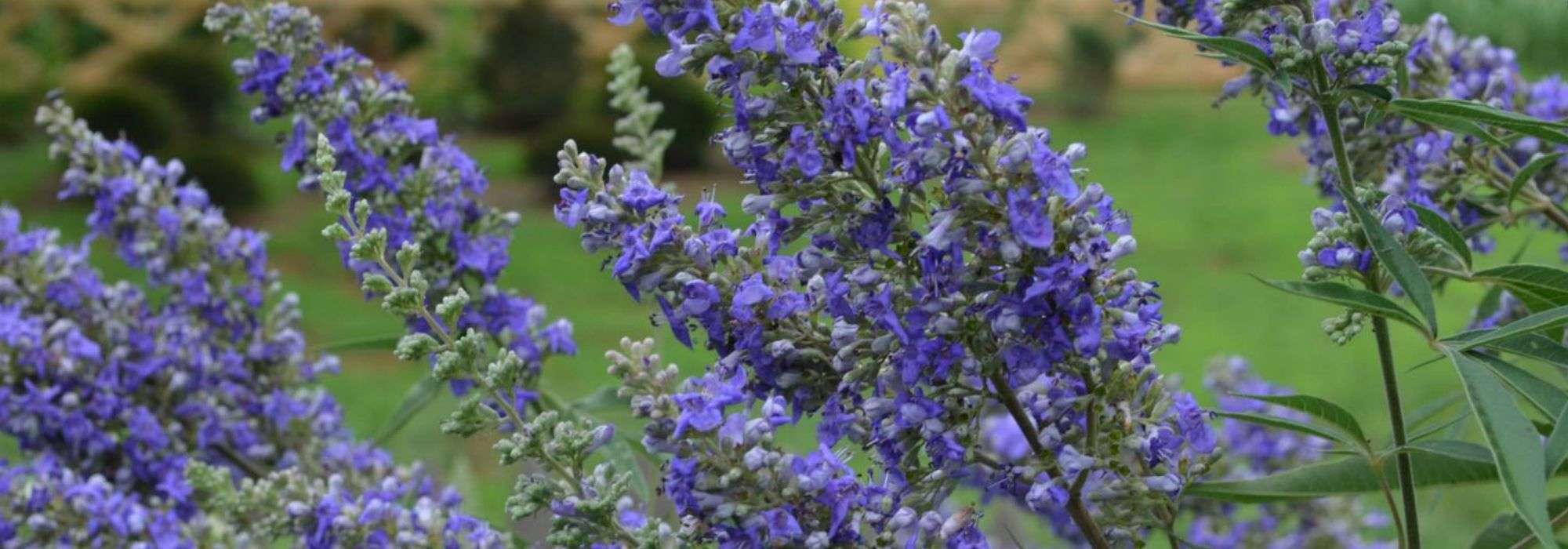
Vitex agnus-castus, chaste tree: planting, growing, pruning
Contents
Vitex or chaste tree in a nutshell
- Vitex is a handsome all-terrain bush that grows everywhere, in full sun even in poor soils
- Its scented blue, mauve or white flowering is very bright in summer and its attractive deeply divided aromatic foliage gives off a peppery scent
- It is also known for its berries reminiscent of pepper
- Hardy and tolerant, it tolerates lime, drought but also sea spray; it is easy to grow in drained soil
- It is indispensable in country hedges, as a solitary specimen and in borders of bushes, and has its place in all dry and coastal gardens
A word from our expert
Vitex agnus-castus, commonly called “chaste tree“, “monk’s pepper” or gattilier is among easiest flowering bushes to to grow. Forgotten in gardens, Vitex agnus-castus, literally “chaste lamb“, has in recent years made a well-deserved comeback on horticultural scene because it has more than one asset; a long, unassuming late flowering from July to October, very aromatic foliage and edible fruits usable as substitute for pepper.
Therapeutic benefits of gattilier berries have been known since Antiquity and are still used today as a natural remedy for disorders related to premenstrual syndrome, menopause and amenorrhoea, or to promote female fertility and implantation.
From Vitex agnus-castus ‘Albus’ or ‘Alba’ with white flowers, to Vitex agnus-castus ‘Delta Blues’ with vivid violet-blue blooms, via Vitex agnus-castus ‘Blue Puffball’, a new variety of gattilier with very reduced growth, not forgetting Vitex negundo and Vitex agnus-castus ‘Latifolia’ with very incised foliage, all bring a touch of simplicity and freshness to a flowering hedge, as a specimen, in a bed of bushes and even on a terrace.
With good frost hardiness (often beyond -15°C), undemanding, easy to to grow and very vigorous, Vitex thrives in sun in any well-drained soil. It adapts to all gardens as well as small spaces.
Planting, care, here are all our tips to successfully grow our Vitex or gattiliers and ensure a splendid summer in flower!
Description and botany
Botanical data
- Latin name Vitex
- Family Verbenaceae
- Common name chaste tree, pepper tree, monk's pepper, chaste berry
- Flowering July to October
- Height 1.10 to 5 m
- Exposure Sun
- Hardiness -15°C
Vitex agnus-castus, literally “chaste berry”, also called chaste tree, gattilier, pepper tree or monk’s pepper, belongs to family Verbenaceae. This aromatic bush or shrub originates from poor, well-drained soils and dunes of the Mediterranean basin, particularly Greece and Italy, and from Asia Minor.
The genus includes more than 200 species, with Vitex agnus-castus being the most widespread in our temperate zones.
With fairly rapid growth, Vitex forms a rounded, bushy shrub with a lax, spreading habit, sometimes a little untidy. Mature plants typically reach, depending on variety, 1.50 to 3 metres, rarely exceeding 4 metres in any dimension and are ideal for creating flowering, natural-looking hedges. Vitex agnus-castus develops a very deep root system and can attain century-long longevity.
The beige-grey bark flakes with age, forming scaly fissures on the trunk.
The deciduous, deeply divided foliage varies noticeably between varieties. Quadrangular, often chapped and very flexible stems bear opposite, palmate leaves with a long petiole, composed of 5 to 7 lanceolate leaflets with smooth margins, the two basal ones being shorter. The fan-like shape evokes a cannabis leaf. The Vitex agnus-castus ‘Latifolia’ or large-leaved gattilier is distinguished from the typical form by broader, shorter foliage.
Leaves are glossy above with a velvety whitish underside and a prominent chartreuse mid-vein. They appear in spring in shades of light green, grey-green to dark green, sometimes attractively purplish, as in cultivar ‘Flip Side’®. Gattilier leaves are aromatic and give off an intense peppery scent when crushed, as does the whole plant, hence the common name “pepper tree”.

Vitex agnus-castus – botanical illustration by PJ Redouté
In summer, dense spikes of fragrant flowers drape this elegant foliage. From July to October, at a time when few other plants are in bloom, Vitex branches are covered with beautiful axillary panicles in varying colours reaching 10–20 cm in length. This flowering, reminiscent of buddleias, takes place on current-year shoots. Flower buds, tightly packed, open progressively into small flowers 7–8 mm long, tubular and almost bilabiate with five unequal lobes and prominent stamens. They are downy on the reverse. These whorls occur in shades of blue ‘Blue Puffball’, violet, pink and pure white Vitex agnus-castus ‘Albus’.
Highly melliferous, these peppery-balsamic scented flowers are much visited by pollinating insects and irresistibly attract butterflies and bees.
In autumn, clusters of round, edible, fragrant berries 4–5 mm in diameter, resembling bright red peppercorns follow the flowers and persist through winter. They have a spicy flavour and can be used as a substitute for pepper.
Perfectly hardy beyond -15°C, Vitex agnus-castus or gattilier adapts to all our climates and is very easy to grow in very sunny positions in ordinary, well-drained soil, even poor, stony or calcareous. Undemanding about soil type, it is an all-terrain shrub that also tolerates sea spray and adapts to saline and sandy soils.
It finds its place in all natural gardens, dry gardens, coastal gardens or urban gardens. It performs wonderfully as a specimen, in shrub borders or groups, in flowering hedges or even on a terrace or balcony, planted in a large container for smaller varieties.
Vitex has long been associated with chastity. In the Middle Ages some monks consumed its berries for their anaphrodisiac properties to resist fleshly temptations.

Several colours of Vitex : ‘Delta Blues’, ‘Latifolia’ and ‘Alba’
In herbal medicine, berries and leaves of gattilier are used to relieve hormonal pain in women and to regulate the menstrual cycle. Its peppery seeds can be used as a condiment. In the past, Vitex stems were used, like wicker, to make strong ties and trellises.
Read also
10 perfect bushes for a seaside gardenMain species and varieties
Alongside flowering of classic blue-violet colour of the type species, cultivars derived from it offer a more diverse palette, ranging from white to pink and lilac. Some Vitex also stand out for the striking colouration of their foliage, others for a more modest size that allows use in small spaces or in containers on a terrace.
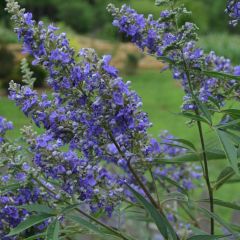
Vitex agnus-castus Delta Blues - Chaste Tree
- Flowering time August to October
- Height at maturity 2,75 m
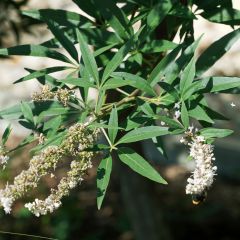
Vitex agnus-castus Albus - Chaste Tree
- Flowering time August to November
- Height at maturity 4 m

Vitex agnus-castus Blue Puffball - Chaste Tree
- Flowering time August to October
- Height at maturity 1,10 m
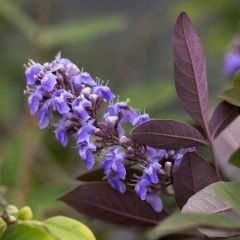
Vitex agnus-castus Flip Side - Chaste Tree
- Flowering time August to October
- Height at maturity 2,50 m
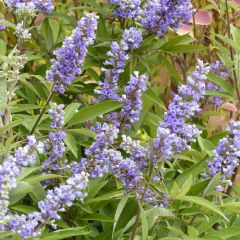
Vitex agnus-castus f. latifolia - Chaste Tree
- Flowering time August to October
- Height at maturity 2,75 m
Discover other Vitex - Chaste tree
View all →Available in 1 sizes
Available in 0 sizes
Available in 1 sizes
Available in 1 sizes
Available in 1 sizes
Available in 2 sizes
Available in 1 sizes
Available in 1 sizes
Available in 1 sizes
Available in 1 sizes
Planting Vitex
Where to plant?
The Vitex or chaste tree agnus-castus is one of the easiest flowering bushes to grow. To flower well, it must be planted in full sun, in a warm position sheltered from cold, drying winds that could damage its foliage. Although it shows good frost hardiness down to at least -15°C in well-drained soil, it is still vulnerable to very severe frosts, but will regrow from the stump in spring. In cold areas, plant against a sunny wall.
It tolerates sea spray and will cope well with summer drought once established. With an exemplary undemanding nature, it thrives in any soil that is not too wet, salty, sandy, poor or even calcareous, provided it is well drained, as this bush of arid lands fears excess moisture.
With its versatile nature, Vitex finds a place in all natural gardens, dry, coastal or urban gardens, forming attractive focal points. It can be used throughout the garden, as a specimen, in shrub borders or grouped into informal hedges. Some compact varieties such as Vitex agnus-castus ‘Blue Puffball’ are particularly suited to small spaces and to container growing and can be included in small perennial fronts or as foreground plants in shrub borders.
When to plant?
Plant Vitex preferably in spring, from March to May in cold regions when risk of frost has passed to encourage good regrowth. Elsewhere, planting in autumn, from September to October, to encourage rooting before winter is also possible.
How to plant?
In open ground
Depending on variety, allow a density of 1 bush per m2. For planting as a hedge, allow 1 to 3 m between each Vitex or other bush. When planting in open ground, improve drainage if necessary using coarse gravel mixed half-and-half with garden soil. Water regularly during the first summer.
- Dig a hole twice the size of the rootball and loosen the soil well
- If necessary, lay a thick bed of gravel or clay balls at the bottom of the hole to aid drainage
- Place the bush centrally in the planting hole so that the rootball is level with the soil surface
- Backfill with garden soil
- Firm soil around the base of the bush and water
In a pot
Compact Vitex varieties (such as the Blue Puffball) are perfectly suited to container growing and make a striking feature on a terrace where they release their peppery scent in summer.
- Choose a container large enough, at least 60 cm high, so the bush can develop well
- Lay a drainage layer of expanded clay balls or pumice
- Plant your vitex in a mix of leaf mould and garden soil
- Place the pot in full sun
- Water fairly regularly during the first summer, allowing soil to dry between waterings
- Repot every two years into a larger container
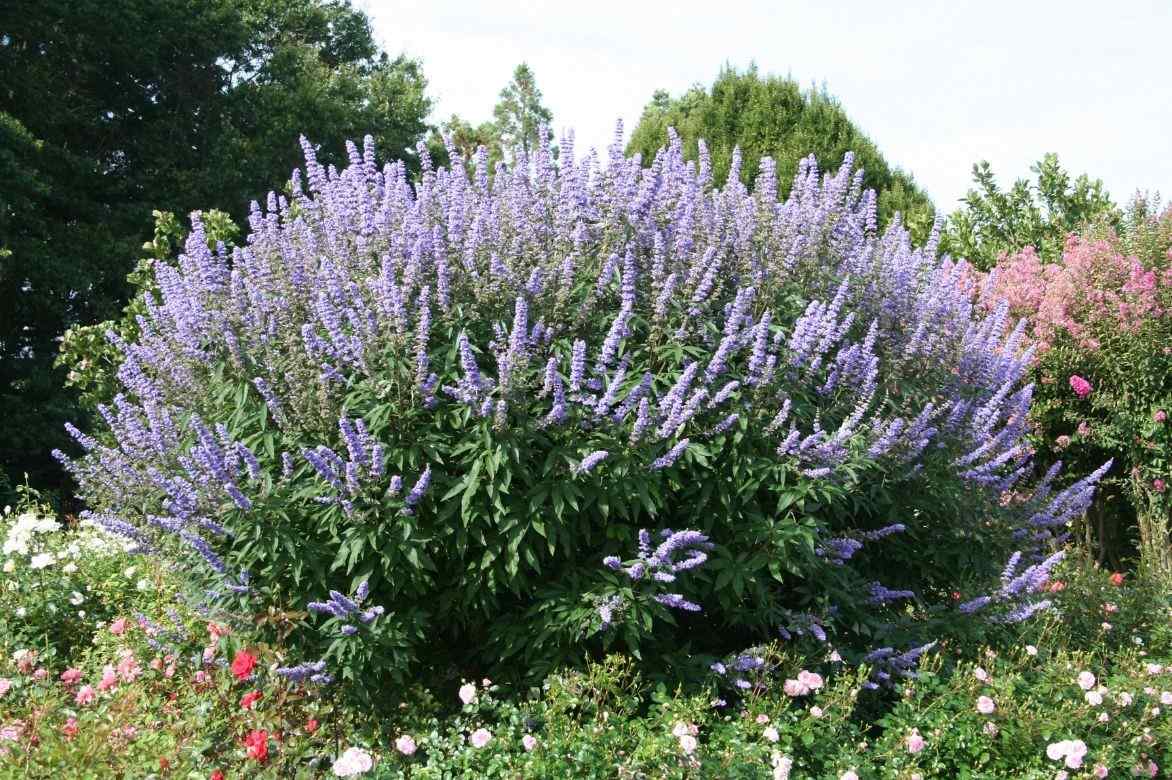
Maintenance, pruning and care of Vitex
Hardy, drought-tolerant, le Vitex est un bush robuste qui demande peu d’entretien : pas d’engrais, peu d’arrosages. Il est le compagnons idéal des jardins secs sans entretien !
Water young bushes during first summer to help rooting and for first two or three years in case of prolonged heat. Afterwards, let nature take its course, and only water during long periods of drought, it will be content with rainwater.
In a pot, let soil dry out between waterings and in regions with rainy winters, bring pots indoors for shelter.
In coldest regions, mulch plant base from autumn to protect roots from severe frosts.
Chaste tree correctly established has no significant pests, and its peppery scent also repels pests!
When and how to prune?
Pruning of the Vitex is not obligatory, but it helps maintain a compact and bushy habit: carry out this operation at end of winter or early spring. As with all summer-flowering bushes, Vitex flowers on current year’s wood, a very short pruning will encourage growth of new branches and the upcoming flowering will not be threatened but rather stimulated! No worries, it tolerates this type of pruning well!
- In March, before growth resumes, cut back shoots that have flowered by three quarters with pruning shear, leaving only 2 or 3 eyes or buds
- Remove dead wood and wayward branches that cross
- Open up centre of branches to improve airflow
And follow our advice to prune summer-flowering bushes properly
Multiplication
Taking cuttings of chaste tree
Propagation of Vitex can be carried out in August on semi-ripe or semi-woody shoots (i.e. those that change from soft wood to hard wood). Expect 2 to 3 years before first flowering. Sowing is possible with fresh seeds in autumn but is more unpredictable and takes longer.
- Take current-year shoots without flowers, 15 to 20 cm long
- Remove lower leaves and keep only two pairs of terminal leaves
- Cut them in half
- Plant the cuttings in buckets filled with potting compost and sand
- Overwinter them frost-free under a cold frame
- Keep growing medium moist
- Plant out cuttings in open ground the following spring
Companion plants for chaste tree
With its fragrant flowering combining freshness and simplicity and with its modest dimensions, Vitex agnus-castus is suitable for large and small gardens, planted as a specimen, at the back of a perennial border or grouped in informal country hedges, or even in a container. It pairs easily with all sorts of plants in a natural garden or a seaside garden as it tolerates sea spray well.
It is wonderful in a flowering hedge mixed with all types of flowering bushes such as Ceanothus or Californian lilac, weigelias, a smoke bush, Althaeas, lavateras and other shrubs such as Buddleias.
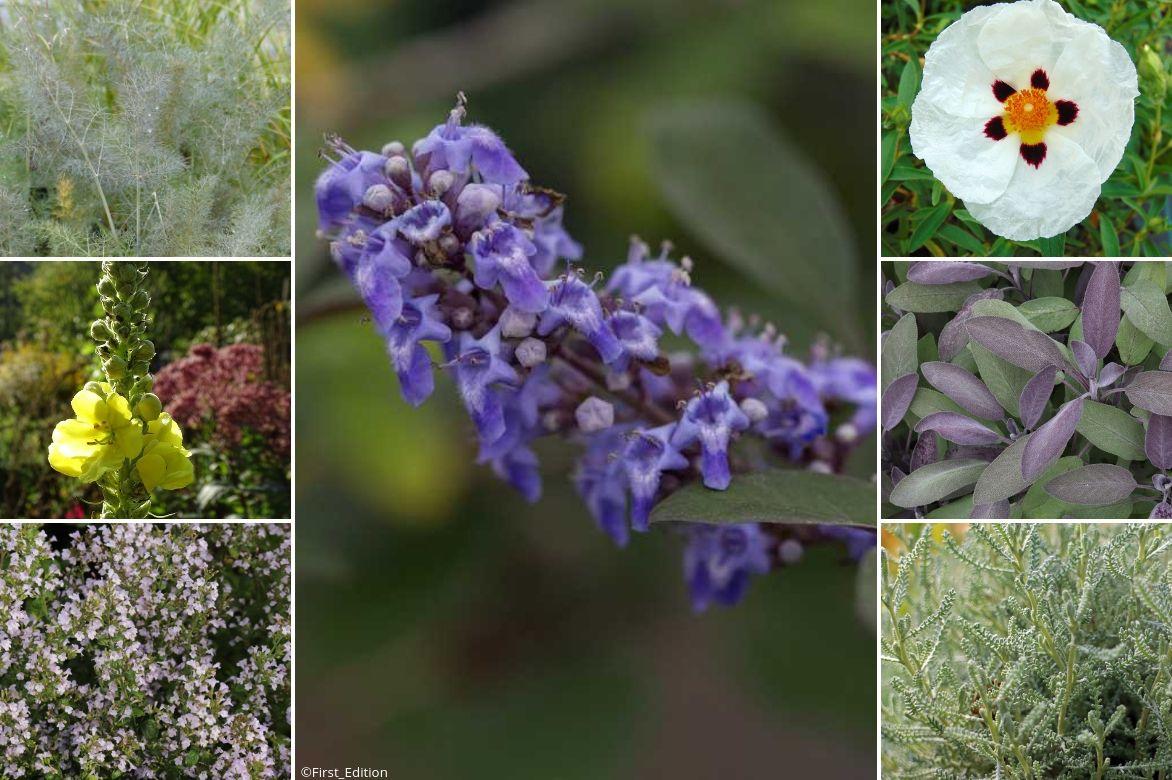
A lovely planting idea: Vitex agnus-castus ‘Flip Side’ as centrepiece, accompanied by Cistus ‘Alan Fradd’, Salvia officinalis ‘Purpurascens’, Santolina chamaecyparissus, Foeniculum ‘Bronze’, Verbascum thapsus and Calamintha nepeta. Add a few clumps of Stipa gigantea and it will be perfect !
Its bushy silhouette helps to fill out a natural shrub or perennial border, adding plenty of charm. Place it at the back, for example alongside a Lagerstroemia.
In the foreground of a shrub border, modest-sized chaste trees go well with oleanders, dwarf buddleias or with Tamarix.
In the middle ground of a mixed border of full-sun perennials, it lightens the whole and mixes easily with sages, Alcea rosea, Achillea millefolium, summer asters, Nepetas, lupins, Oriental poppies, echinaceas, creating abundant, generous displays.
Larger specimens make magnificent backdrops for old-fashioned or English roses.
It offers one of the garden’s finest blues — create a blue-themed border by pairing it with Butterfly bushes ‘Adonis Blue’, ‘Blue Chip’, and blue-flowering perennials such as Delphiniums, Knautia arvensis, Echinops, Perovskia, a Salvia nemorosa or Verbena bonariensis, or a Lupinus ‘The Governor’.
With blue, pink or white flowering it appears in romantic scenes punctuated by clumps of lavender and grasses such as Miscanthus, together with clematis, campanulas, Thalictrum. In blue/yellow combinations, contrast it with Symphorines, yellow daylilies, drought-tolerant euphorbias, St John’s wort and shrubby potentillas.
Smaller-growing varieties are well suited to container culture mixed with hardy geraniums, phlox or dianthus or lavenders.
Useful resources
- Discover our different varieties of Vitex in our online nursery
- Do you like bushes with blue flowers? Discover our article: 8 bushes with blue flowers you should have in your garden
- Discover our selection of 10 bushes that thrive in seaside gardens!
- Also discover our selection of 10 summer-flowering bushes you should have in your garden!
- Subscribe!
- Contents
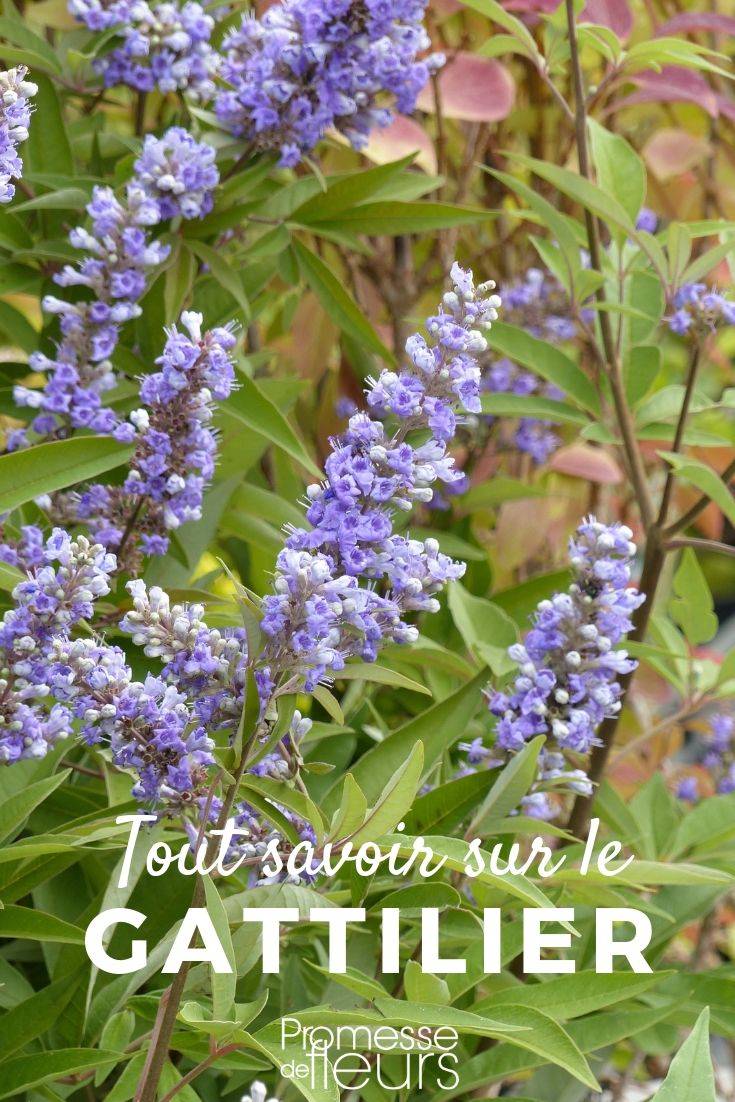
































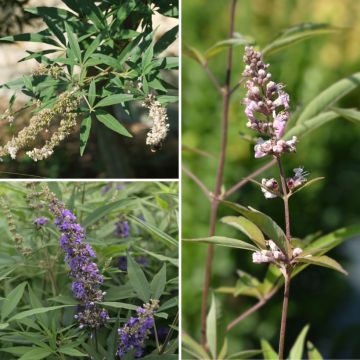
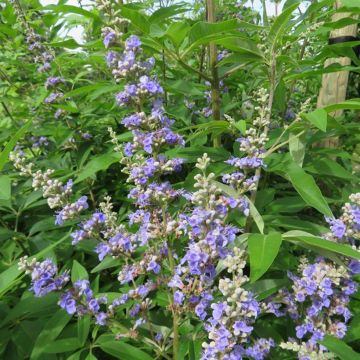

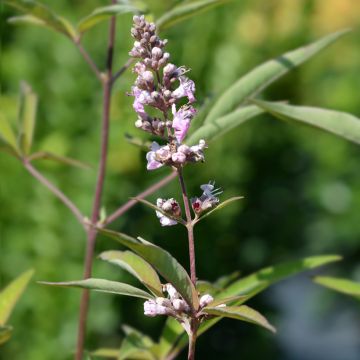

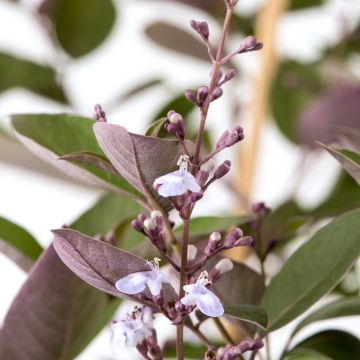
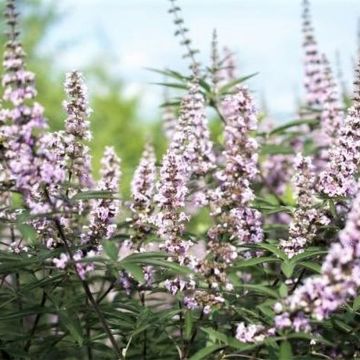
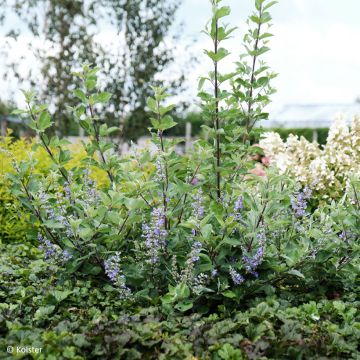
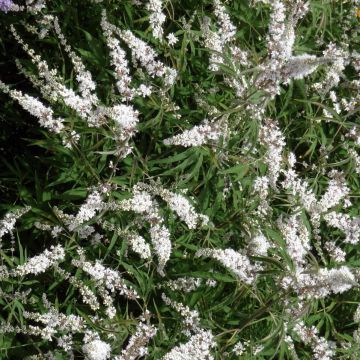
Comments